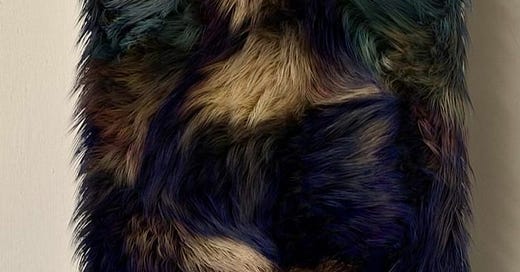Welcome to the Sociology of Business. If you are not subscribed, join the community by subscribing below and share it with everyone you think may find it useful. You can find my book, The Business of Aspiration on Amazon and you can find me on Instagram and Twitter. For those new here, I did the Lessons from Cash App analysis, which focused on why turning commerce into culture is the best go-to-market strategy.
The Furry Lisa, a digital piece of art created by Murat Yıldırım, is a symbol. It is physically soft and inviting, but it exists only in the digital domain.
Baudrillard would be thrilled. Forty years ago, he suggested we have “replaced all reality and meaning with symbols and signs, and that our experience is a simulation of reality. The distinction between reality and representation vanishes. There is only the simulation, and originality becomes a totally meaningless concept.”
Reality, symbols and society now have an inverse relationship. Last Fall, Balenciaga launched its Afterworld collection in Fortnite. Since then, Balenciaga’s print ads featuring Justin Bieber look like they came straight from Fortnight. (Baudrillard would have called this “the third order of simulacra,” where the representation precedes and determines the real.)
Luxury has always been in the business of simulation: of making its stories believable by the massive numbers of people. Coco Chanel was an artist; Louis Vuitton was a craftsman; Hermès has inimitable heritage; Ralph Lauren is about American aristocracy; Möet Hennessy has been made according to a secret recipe transmitted over generations. People believe a luxury brand is valuable because others believe it is valuable; the more we believe something’s valuable, the more valuable it becomes.
Luxury is a simulation. So is crypto. Arbitrary images represent things they have no relationship to (Doge Crown? A Bored Ape?) Gucci, Dolce&Gabbana, Balenciaga or Burberry are all creating fashion that we’re never wear our physical bodies. This makes them no less desirable or believable.
Signs and simulation have a great aspirational power (just look at the decoupling of value and price in the current art market). Luxury and crypto assets’ aspirational power fuels modern economy, where the growth motor doesn’t come from physical products, but from the story-rich intangibles like a virtual crown or a pixelated cartoon character.
Here are some scenarios for business and brand growth in the luxury crypto world.
Business
Value-add. Most valuable assets are those that combine physical and digital benefits: e.g. a Gucci jacket has both the use value and exchange value thanks to being associated with a digital collectible. Both the jacket the digital asset linked to it the provide VIP access and membership perks (invites to fashion shows, brand experiences, private events, preferential product access, skipping levels and lines) in the digital and physical worlds. This is a value versus volume strategy that secures revenue without overproduction, over-inventory and discounting.
Fractional ownership. Capsules and special collections come with selling ownership rights of individual products via crypto. If one buys a token attached to a product in a collection, they will receive royalties from the product sales down the line. Example: Particle is program where ownership of a Banksy painting plans to be sold off as 10,000 NFT fractions.
Choose one of the paid subscription options to access the rest of this analysis, including a wealth of strategic brand and business directions to position you for the future growth.
Keep reading with a 7-day free trial
Subscribe to The Sociology of Business to keep reading this post and get 7 days of free access to the full post archives.




